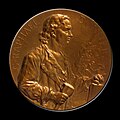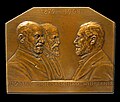Stefan Schwartz
Stefan Schwartz (born August 20, 1851 in Neutra , Kingdom of Hungary ; † July 31, 1924 in Raabs an der Thaya , Austria ) was a sculptor and medalist .
Stefan Schwartz, the son of a carpenter, was originally supposed to become a clergyman before he first worked in a metal goods factory in Pest and then learned the chaser trade in Vienna . From 1869 to 1874 he studied at the Vienna School of Applied Arts under Otto König . After various study visits, he was appointed to the same school in 1876 through the mediation of Ruolph von Eitelberger-Edelberg as a teacher. Arnold Hartig was one of his students .
As early as 1875, he and Rudolf Mayer ran their own goldsmith and chisel school. One of his pupils was the Swiss medalist Hans Frei .
In 1896 Schwartz received a small gold medal at the International Art Exhibition in Berlin .
He became famous, among other things, for the portrait of the emperor on the Austrian crown in silver and gold. Emperor Franz Joseph (without a laurel wreath) is depicted on it with the artist's signature. This peculiarity shows the importance of the artist for the imperial family.
The largest part of his estate is now administered by the Museum of Applied Arts in Vienna. A corresponding catalog raisonné was created by the art historian Monika Holy.
Works
Friedrich Schiller , German doctor and poet, obverse of the medal on the 100th anniversary of death in 1905 , based on Dannecker 's bust from 1794.
Count von Stadion receives the patent from Emperor Franz I of Austria to found the Austrian National Bank in Vienna . Bronze medal for the 100th anniversary on June 1, 1916, obverse
Think, Matscheko, Wilhelm Exner
Old TGM in Währinger Straße , today WUK
Famous gold coin from Stefan Schwartz depicting Emperor Franz Joseph I.
literature
- Peter B. Hauser : Stefan Schwartz - Medailleur - Family biography and medal catalog, self-published, Linz, 1994
- Monika Holy : Stefan Schwartz: sculptor, medalist and chaser in Vienna, 1851 - 1924 . Self-published, Vienna 2007.
- W. Krause: Schwartz Stefan. In: Austrian Biographical Lexicon 1815–1950 (ÖBL). Volume 12, Verlag der Österreichischen Akademie der Wissenschaften, Vienna 2001-2005, ISBN 3-7001-3580-7 , p. 5 f. (Direct links on p. 5 , p. 6 ).
Web links
- Entry on Stefan Schwartz in the Austria Forum (in the AEIOU Austria Lexicon )
- Proof of the alternative spelling of the first name (PDF; 1.6 MB)
- Stefan Schwartz / Wiki platform for documentation and research on the monuments of the University of Vienna
- Stefan Schwartz in the Vienna History Wiki of the City of Vienna
- Stefan Schwartz, The Triumph of the Artist / Digital Belvedere
Individual evidence
- ^ L. Forrer: Biographical Dictionary of Medallists . Schwartz, Prof. Stephan. Volume V. Spink & Son Ltd, London 1912, pp. 425 ff .
| personal data | |
|---|---|
| SURNAME | Schwartz, Stefan |
| BRIEF DESCRIPTION | Austrian medalist |
| DATE OF BIRTH | August 20, 1851 |
| PLACE OF BIRTH | Neutra |
| DATE OF DEATH | July 31, 1924 |
| Place of death | Raabs an der Thaya |











